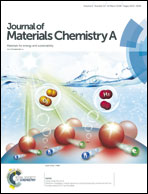Mechanically robust and high-performance ternary solar cells combining the merits of all-polymer and fullerene blends†
Abstract
In this study, we demonstrate that the introduction of small amounts of phenyl-C71-butyric acid methyl ester (PC71BM) into all-polymer solar cells (all-PSCs) increases the photovoltaic performance without compromising mechanical properties. Ternary blend polymer solar cells (ternary-PSCs) consisting of a polymer donor (PTB7-Th) and an acceptor mixture with different weight ratios of a polymeric acceptor (P(NDI2HD-T2)) and PC71BM demonstrate the effects of PC71BM loading on the power conversion efficiency (PCE) and mechanical properties. A significant enhancement in the PCEs of ternary-PSCs, from 6.32% to 7.33%, is observed when PC71BM is added into the active layer as up to 30 wt% of the acceptor mixture. Importantly, the excellent mechanical properties (i.e., crack onset strain = 11.6%, toughness = 2237 J m−3) of the blend films are well preserved at PC71BM loadings at or below 30 wt%. In contrast, both the PCE and the mechanical performance of the ternary-PSCs significantly decrease at higher PC71BM loadings (>50 wt%). Detailed morphological analysis via grazing incidence X-ray scattering measurements reveals that PC71BM molecules are well-dispersed in the amorphous portion of the active layer at PC71BM loadings up to 30 wt%. Therefore, both the mechanical and photovoltaic performances of the ternary-PSCs correlate closely with their morphological behavior, particularly in terms of the mixing behavior of PC71BM with polymers. The well-dispersed PC71BM molecules in the amorphous polymer domains facilitate efficient exciton dissociation, whereas the formation of PC71BM aggregates above a critical concentration causes severe mechanical degradation of the ternary-PSCs due to the presence of weak interfaces between the brittle PC71BM and polymer domains. Therefore, the ternary blends with optimal content of polymer/fullerene acceptors represent important candidates for flexible and wearable solar cells that require both high mechanical and photovoltaic performances.



 Please wait while we load your content...
Please wait while we load your content...